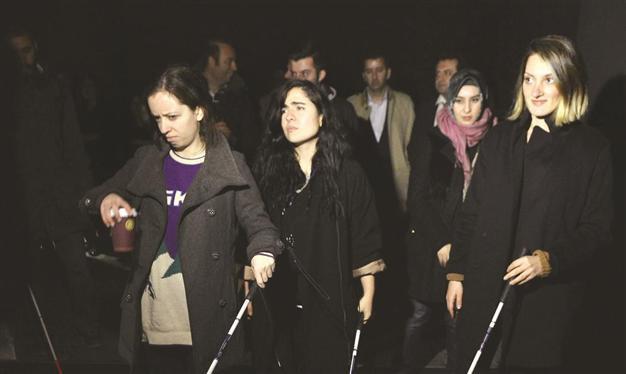Exhibition in the dark
ISTANBUL

The exhibition consists of a series of rooms in complete darkness. Escorted by the guide, visitors spend 60 to 90 minutes exploring darkened galleries: a public park, a bustling city street, a food market, a boat, and a cafe, to name a few. AA photo
The exhibition titled “Dialogue in the Dark,” which attempts to show the feelings of visually handicapped people to the others, was opened over the weekend in Istanbul’s Gayrettepe Subway Station.
The exhibition consists of a series of rooms in complete darkness. The visitors, in groups of up to 10 people, get a short briefing and are introduced to the use of a long cane before embarking on the journey through darkness. Escorted by the guide, they spend 60 to 90 minutes (depending on the size of the exhibition) exploring darkened galleries: a public park, a bustling city street, a food market, a boat, and a cafe, to name a few.
Within this new paradigm, guides open the visitors’ eyes to show them that the world of the blind, the world of the “other,” is in no way poorer – just different.
Reaching more than 7 million people in 130 cities in the world, the exhibition’s Istanbul leg organized a tour for press members before the opening.
The founder of the “Dialogue in the Dark exhibition,” Andreas Heinecke said at a press conference, which was held in a dark atmosphere, that the exhibition had a history of 25 years and 2,000-3,000 visitors everyday felt the experiences of blind people.
He said one of the exhibition’s goals was to make use of the abilities of visually handicapped people. He said, “People ask me ‘are you doing something for the blind?’ I tell them ‘I do not do anything for them but with them.’ This exhibition is not for the blind, but for people. I believe every person has value. I actually think blindness may be a precious feature. We can learn something here from the communication we establish with the blind. People, who are visually healthy, get chance here to know themselves better. They realize the importance of trust and communication. We are very happy we opened this exhibition in Istanbul. We want the people of Istanbul to come here. The exhibition will become a turning point in the life of its participants.” Heinecke said in the exhibition, all guides are blind or partially sighted people, adding, “It is already their daily routine to be in the dark.”
The founding partner of the exhibition, Hakan Elbir said due to the project, 30 blind people had been employed. He said blindness was used as a metaphor in the exhibition; people’s empathy improved and they had a very different feeling there.
Number of blind people 45 million One of the sponsors of the exhibition, Dünyagöz Executive Board Director Gülferi Meral Yıldırım said the ability to see tied people to life, and continued:
“According to data from the World Health Organization, 145 million people have visual problems. Among them, 45 million are completely blind. If it had been diagnosed earlier, 80 percent of these people would be able to see now. We followed this project in other countries for a long time. We believe it is very important to realize the importance of the eye’s health.”
Istanbul Metropolitan Municipality official Bekir Köksal complained that a big part of the society was not aware of people with disabilities. “This project is important in changing this,” he added.
The exhibition, which covers an area of 1,500 square meters in the Gayrettepe Subway Station, offers an entirely dark atmosphere. Accompanied by blind guides, participants feel Istanbul’s unique sounds and smells using white walking sticks, and experience the use of parks, bridges, subway and a plane.
They watch the film made for the blind and use the Internet. They also talk in a dark café. Thirty blind people are working for the exhibition.
